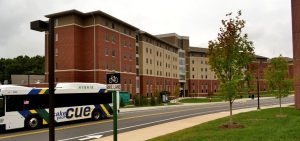According to the US Green Building Council (USGBC), buildings account for approximately 40% of the nation’s total energy consumption, 14% of its water use, and 40% of emissions. At George Mason University, our buildings produce 71% of our emissions and we spend close to $10 million a year in energy costs. If we can reduce our building energy consumption, not only will it make a positive impact on the environment, it can free up funds for other important benefits and services for Mason’s students, faculty, and staff members.
Mason builds its buildings to USGBC’s Leadership in Energy and Environmental Design (LEED) Silver, Two Green Globes, or to the Virginia Energy and Environmental Standard (VEES). We outline our goals to our design teams with our University Design Information Manual.
If you want to help Mason reduce the environmental impact of its buildings, you can join our Green Office program, certifying your office as a sustainable space, or our Green Residence program, greening your residence hall.
If you are interested in a self-guided tour of our green buildings on campus, please click or visit the links below. Access to certain buildings may be restricted:

LEED Gold:
- Eastern Shore (2012)
- Hampton Roads (2012)
- The Global Center (2010) *Cabrera Global Center
LEED Silver:
- Fenwick Library (2020)
- Peterson Family Health Sciences Hall (2021)
- Ike’s Dining Hall (2016)
- Taylor Hall (2016)
- Exploratory Hall (2015)
- Nguyen Engineering (2010)
- Smithsonian Housing
- Horizon Hall (2023)
LEED Certified
- Vernon Smith Hall (Founders Hall) (2012)
Anticipated/In Progress
- Point of View
- Potomac Science Center
- FUSE at Mason Square
- Life Science Engineer Building
- Activities Building
Virginia Energy Conservation and Environmental Standards (VEES) certified
- Rogers: VEES
- Whitetop: VEES
